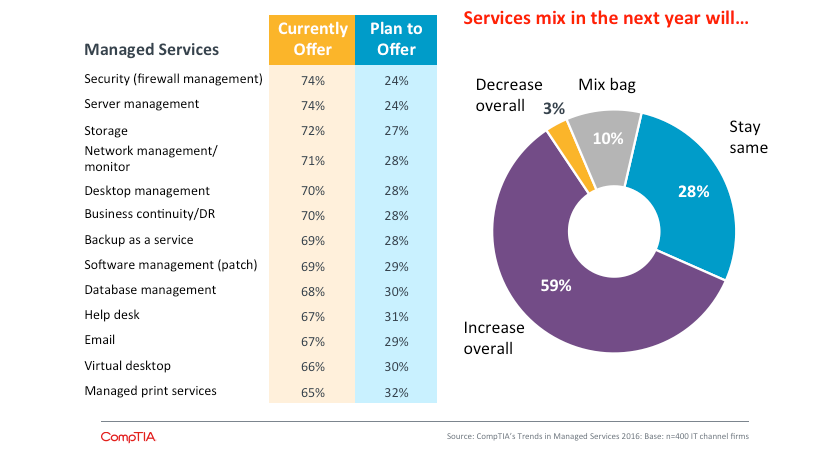CompTIA Partner Advisory Council Members Offer Best Practices at ChannelCon
One of the toughest things for new IT services business owners is planning out their portfolios. What do you need to get started and which offerings will be required to attract and retain new customers? Each additional service will typically require some of your limited resources, including capital and time. Vendors have to be vetted, technical and sales staff will need training, and marketing dollars will have to be assigned to introduce and promote any new offering. Those processes aren’t easy or inexpensive, especially when you’re starting a business and trying to deal with the numerous issues every new entrepreneur faces. 
Over time, most providers end up solving their initial growing pains and end up building a fairly large catalog of offerings. According to the 5th Annual CompTIA Trends in Managed Services report, MSPs are offering more services in their portfolios than ever before. Security, server management, storage, network management and desktop management are five of the top choices, but a significant majority of providers are also offering BDR, email, help desk and managed print services.
Based on the conversations between CompTIA Partner Advisory Council (PAC) members during their meeting at ChannelCon, this expansion is not just based on competitive pressure ̶ though that is one reason for the upward trend. MSPs are adopting comprehensive portfolios based on the varying and escalating needs of their customers. More specifically, an expanded catalog helps providers address specific issues that different end users are dealing with inside their client organizations. In the end, technology is all about improving productivity, strengthening the customer experience, ensuring compliance measures are in place and protecting data.
That last point is huge. IT security is not only crucial to your clients’ long-term viability, but a lead in to new business opportunities for channel firms. “Security seems to be driving a lot of our discussions today, the conversations that turn us into true business partners,” says PAC member Lester Keizer, CEO-Co-Owner at Business Continuity Technologies. “It also creates insightful selling opportunities, allowing you to inform them about issues they may not know about and to convince them to take the appropriate road.”
 In fact, without the right support and information, companies often take the wrong (and more expensive) path. High dollar solutions are not always the answer. “The exploitations we are seeing are still fairly basic and, if I had to pick one thing partners should be offering today, it would be end user education,” emphasized Joe Infante, Co-Founder and President of Dynamic Strategies. “Security starts with policies and procedures and some clients may push even want a sandbox ̶ which is really overkill if the other things aren’t nailed down.”
In fact, without the right support and information, companies often take the wrong (and more expensive) path. High dollar solutions are not always the answer. “The exploitations we are seeing are still fairly basic and, if I had to pick one thing partners should be offering today, it would be end user education,” emphasized Joe Infante, Co-Founder and President of Dynamic Strategies. “Security starts with policies and procedures and some clients may push even want a sandbox ̶ which is really overkill if the other things aren’t nailed down.”
Matt Hahn, VP of Technology for Network Services SWK Technologies also suggests offering Pen (penetration) and vulnerability testing to ensure your clients are properly protected. “You have to educate end users on their real vulnerabilities, and email spoofing and robo calls are a great way to start. You immediately become a trusted advisor with those types of services.”
Another point of emphasis during the discussion is that MSPs don’t have to build out security practices on their own. “We pull in experts from our vendors to discuss security with our large clients and, frankly, many of our customers’ CIOS don’t know anything about protection,” says Dave Dyson, CEO of Eclipse Telecom. “You have to realize that mid-market companies know as much about what they’re doing as SMB customers do. They both have a long way to go.”

 Add CompTIA to your favorite RSS reader
Add CompTIA to your favorite RSS reader

